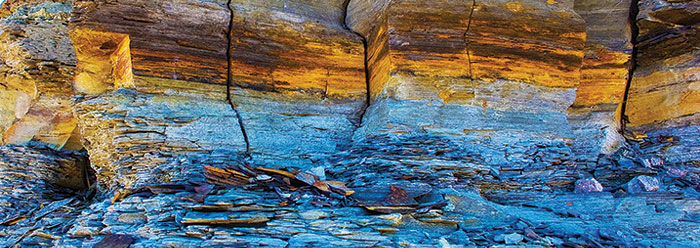Oil resources are in the news nearly every day, with discussions on both the pros and cons of oil “fracking.” Approximately 10 percent of the world’s recoverable oil reserves are in shale-rich rocks that can only be accessed by hydraulic fracturing (i.e., fracking).1 A 2013 study estimates there are about 345 billion barrels of recoverable shale oil. These same shale-rich rocks also account for up to 32 percent of the world’s natural gas reserves.1 The amount of gas recoverable from shale is estimated at around 7,300 trillion cubic feet in volume.
When we stop to consider the early origins of these vast reserves of oil and gas, it’s apparent that these fuel resources are not as “old” as many secular scientists believe. But in order to understand the age of oil, it’s important to start at its source.
Geologists have done many studies over the years, testing the oil produced around the world for its chemical components. They have found that most oil and gas is derived from shale-rich source rocks—rocks abundant in organic debris trapped during deposition. The chemical signatures of both oil and gas often match—much like fingerprints. Shale is the most common sedimentary rock and can serve both as a “seal” and a source rock for oil. Liquids and gases can only pass through shale layers very slowly due to the low permeability of these clay-rich rocks, which tightly seal the oil that seeps into and becomes trapped within them. Hydraulic fracturing creates conduits that allow oil and gas to leak out of these “tight” formations.
Where does the oil and natural gas originate? It all starts with the deposition of organic debris. Many oil shales commonly contain upward of five percent total organic carbon (TOC). Most organic compounds found in oils seem to match up with marine algal deposits (Type 1 oils) and marine planktonic deposits (Type 2 oils). Both types of deposits produce oil and/or natural gas as the rocks are heated by the earth’s natural thermal gradient. These deposits (rocks) just have to be buried deep enough to “cook” and thus generate the oil and gas. Researchers assume that the rocks must be buried between 8,000 and 15,000 feet deep and reach temperatures of 180–250oF in order to generate oil from organic material. This temperature range is commonly called the “oil window,” and local variations in geothermal gradient can shift this window up and down considerably. For example, areas near volcanic activity generally have higher temperature gradients, so nearby sediments may pass through the oil window at relatively shallow depths. If the organic-rich rocks pass through the oil window and continue to cook at higher temperatures, the liquid oil will break down further, leaving only natural gas deposits.
Today, nearly all organic debris is consumed by scavengers or micro-organisms before it becomes trapped in sediment. With this in mind, how is it possible that enough organic debris was ever trapped to produce all of the world’s oil?
The answer is the great Flood, an event that rapidly deposited thousands of feet of sediments across the continents, burying and placing huge amounts of marine sediments—containing algae and plankton—on the continental crust. This process trapped the organic debris faster than it could naturally decay. In many cases, like in the deep sedimentary basins in Wyoming, up to 30,000 or 40,000 feet of sediments were deposited during the year-long Flood—and most of these deposits were clay and shale.
The depth of burial must have been enhanced by rapid tectonic subsidence, as well as simultaneous formation of adjacent mountain uplifts. These shifts placed the organic-rich shales either in the “oil window” or in the higher temperature range that “cooked out” the oil and changed it to natural gas, as mentioned earlier.
Unfortunately for the oil seekers, the organic-rich shales that appear to produce most oil and gas, chemically referred to as hydrocarbons (i.e., simple organic compounds), are mixed and dispersed throughout the geologic strata. This creates complexity—strata with a “club-sandwich” appearance—when searching for oil deposits. Traps or domes (i.e., geologic formations where oil and gas collect and are held) have to be located in the right positions above and adjacent to the organic shales, and the shales have to be in the so-called “oil window” to effectively source the traps.
The Middle East is a prime example of an area that has greatly benefitted because it had just the right conditions to both generate and trap oil. For instance, along with abundant, organic-rich shales that were deposited during the great Flood, this area also has sedimentary rocks with large folds that formed toward the Flood’s end and trapped the oil as it was later generated. The result? Billions and billions of barrels of oil were trapped in this region.
Geologists are constantly searching for oil traps, even in the shales themselves, using increasingly more capable technology. Through wells and using seismic data, they “see” inside the earth as they search for potential new traps around the world. They also employ horizontal drilling techniques to tap into the source-rock shales, enhancing production with sophisticated, hydraulic rock-fracturing. These new technologies have greatly benefitted the economies in Texas, Ohio, and North Dakota, where shale oil is quite plentiful.
Critics of recent creation and the global Flood often try to argue that the sheer volume of oil found cannot be explained by a single ocean full of organic debris deposited in one year-long event. However, the volume of organic material in the ocean at any given time is immense.2 By studying the organic richness of the present ocean, creation scientists have shown that all of the oil found—and yet to be found—could easily be deposited and explained by a single year-long global Flood.3
Nevertheless, many geologists never think through this entire process. They simply focus on searching for traps or rocks folded into domes where they know the oil is likely to be concentrated, without regard for the unusual and specific processes required to preserve the vast amounts of organic debris in the rocks in the first place.
Often, secular geologists insist that most organic oils were generated millions of years ago—even 150 million years ago—and have been preserved and trapped under great pressures ever since. This is a false assumption that is almost never thought through logically. If Earth were truly that old, the oils would have been destroyed by bacterial action, and the geologic pressures would have long since dissipated. We know that oil at the surface is quickly consumed by bacterial action—literally eaten—like in the 2010 Deepwater Horizon oil spill in the Gulf of Mexico.4 We also know that bacteria live in virtually every environment on Earth, even at great depths in the ground. So, it is reasonable to assume any oil beyond a few thousand years old would be totally degraded or consumed by bacteria by now. The oil simply can’t be millions of years old—organic compounds cannot last millions of years in any natural environment. Thus, there shouldn’t be any ancient oil anywhere!
In spite of false assumptions about ancient oil, secular geologists continue to drill, without asking or answering real questions, because the black gold is there waiting for them. Each year, millions of barrels continue to be found in conventional traps and in unconventional “tight” shales through fracking. This abundance and concentration of oil in our world clearly point to the hand of God and the recent Flood.
Global oil generation is another example of a process that could only have occurred because of the extraordinary burial conditions present during the recent great Flood. Most secular petroleum geologists deny the Flood, even though they are witness to this evidence every day as they search for oil. We can be thankful for God’s providence in creating oil, even through a catastrophic, global judgment—oil that now provides much-needed energy for our present world.
References
- Dittrick, P. 2013. Focus: Unconventional Oil & Gas: EIA-ARI Issues Update of World Assessment of Shale Oil, Shale Gas. Oil & Gas Journal. 111 (7): 46-48.
- Woodwell, G. M., et al. 1978. The Biota and the World Carbon Budget. Science. 199 (4325): 141-146.
- Woodmorappe, J. 1986. The Antediluvian Biosphere and Its Capability of Supplying the Entire Fossil Record. In Proceedings of the First International Conference on Creationism, vol. II. R. E. Walsh et al., eds. Pittsburgh, PA: Creation Science Fellowship, Inc., 205-213; Technical Symposium Sessions and Additional Topics.
- Foley, J. A. Oil From Deepwater Horizon Spill Broken Down By Hungry Ocean Bacteria, Researcher Says. Nature World News. Posted on natureworldnews.com April 8, 2013, accessed August 15, 2013.
* Dr. Clarey is a Research Associate at the Institute for Creation Research and received his Ph.D. in geology from Western Michigan University.

















